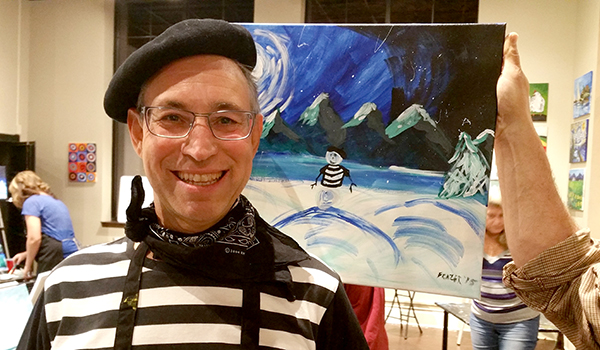
The author displays his “masterpiece” during a firm-sponsored Paint Night.
Lawyers, like artists, are detailed, creative, and curious. Their paths intersect and overlap. In this issue we explore this intersection.
Art is a form of human activity involving creative expression through any number of media or forms. It is universal to the human experience and essential to a well-formed life. Many lawyers themselves are artists or advise artists. Apart from that, lawyers are a reliable audience for artistic expression. Who among us does not enjoy a well-written book, a well-produced movie, one or more areas of the performing arts, various expressions in the visual arts, or elements of commercial or applied art?
Many famous artists at one time practiced law – or have law degrees: Otto Preminger, Henri Matisse, Wassily Kandinsky, Sir Walter Scott, and Studs Terkel to name a few. Probably more lawyers, however, put on their artist hats as an avocation. Some of these individuals are featured in Dianne Molvig’s article, “Lawyers and the Arts.”
 Douglas H. Frazer, Northwestern 1985, is an attorney at DeWitt Ross & Stevens s.c., Brookfield, and a member of the State Bar Communications Committee, which serves as this magazine’s editorial advisory board, and chairs its Content Subcommittee.
Douglas H. Frazer, Northwestern 1985, is an attorney at DeWitt Ross & Stevens s.c., Brookfield, and a member of the State Bar Communications Committee, which serves as this magazine’s editorial advisory board, and chairs its Content Subcommittee.
Some of us are involved in the arts in a professional capacity, representing artists or entertainers, or companies that support and promote them. This issue covers aspects of lawyers’ work in the artist and entertainment area. Jennifer Gregor and Mark Hancock discuss copyright fair use law as it relates to artists, while Elizabeth Russell surveys key provisions in contracts for visual arts and issues authors face in estate planning.
Others of us participate in the arts as volunteers – often as board members of various arts groups and organizations. After moving to Milwaukee, I joined the Present Music board. It was a great way to meet people and to support the arts in general and the kind of art one loves in particular. Lawyers make great board members because arts organizations have legal needs and questions. It’s a natural fit.
There may be another reason, too – which Michael Bowen alludes to in the closing essay. The arts, in many ways, are more improvisational and less rule bound than the practice of law. Lawyers sometimes turn to the arts for a kind satisfaction that they are increasingly less able to find as legal practice becomes more, broadly speaking, corporate. Paula Davis-Laack explores how creative endeavor can improve our lives.
In producing this issue I have been assisted by State Bar Communications Committee members Gretchen Viney, Kristen Degeneffe, Brandon Evans, Jessica Ozalp, Hannah Rock, and Susan Schaubel, and staff members Joyce Hastings and Karlé Lester. Lawyers are so intertwined with the art world that sometimes you forget to stop and think about it. This issue, is a reminder of the many ways lawyers add to, complement, and support the arts – making the fabric of our communities and society the better for it.
